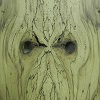I've started a small dining table out of some locally cut sassafras and don't have enough thickness in material to make legs. It will be my first time to attempt something like this(I guess the time has come).
I believe I will have the material to re-saw enough veneer.
I'm planning to use mortise and tenon joinery to attach the aprons to the legs. At this point I'm trying to keep it simple, the legs will be 3-4" square.
My questions are:
What can I use for the substrate for the legs? Is it ok to laminate solid stock together. I know I need to be watching out for expansion/contraction here.
For example would laminating 4 sticks of 11/2"-2" square oak to form the leg be ok and then apply veneer. What about using 4x4 untreated pine.
Just throwing out examples to point me in the right direction.
If I can pull off re-sawing the veneer I'm thinking it will be around 1/8"-3/16" after it is sanded and before it is applied.
I have a wide belt sander so any advice on sanding veneer would be great.
Can I use PVA glue such as tite-bond 3?
I'm hoping to use clamps and cauls as I certainly don't have a vacuum press.
Any advice is greatly appreciated. If I can't pull this off I may just change species for the base or maybe try to source some sass from another part of the country.
Thanks,
Cody





 Reply With Quote
Reply With Quote




 To be continued.....
To be continued.....